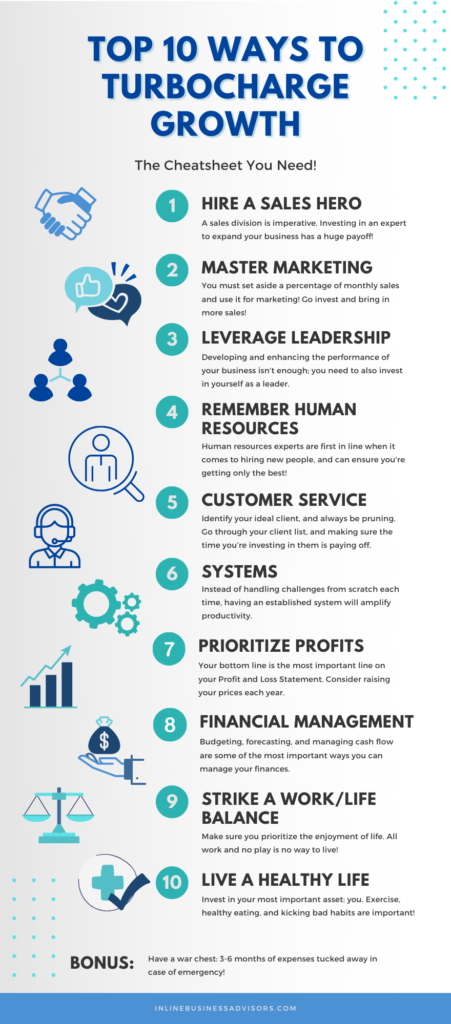Blog

Musings from the coach
If you are a small business owner, you probably know that keeping everything running smoothly can be a huge challenge. From dealing with customers to processing orders, there’s always something that requires constant attention.
Businesses are complex systems with many moving parts, and just like machines require regular maintenance to work optimally, so does a business. If neglected for too long, or if its owner isn’t competent enough to operate it themselves without the right structure, systems, and organization, that business will stagnate or fail because you can’t keep up with everything.
But what if there was a way for your business to run even when you weren’t there? That’s where a Business Operating System, or BOS, comes in. Small businesses need Business Operating Systems for many reasons, including better productivity, easier collaboration between team members, and improved data management. Simply put, your BOS takes care of all the mundane tasks so you can focus on making money and growing your company.
So, what is a Business Operating System, and what are its components? Do all small businesses need a Business Operating System? If so, how do you build one?
In this article, we’ll define what a Business Operating System is, outline the benefits of building one for your small business, the functions it needs to do, and show you how to go about it. Ready to take the plunge? Let’s get started!
What is a Business Operating System?
A BOS is simply a set of rules, procedures, and processes that keep your business running smoothly even when you’re not there to manage it. This system encompasses how your organization operates, implements marketing, produces, and interacts with customers. When established correctly, an effective BOS transcends the people doing and overseeing the work and lends you more efficiency.
In other words, the BOS is an essential component to running and scaling your business. It synchronizes your processes, methods, and mechanisms and powers your business strategy ensuring you succeed. Just as your computer can’t operate without an OS, your business can’t run effectively without a BOS.
A basic Business Operating System is an IT service that helps your company run seamlessly by integrating your business strategies and processes. This software package outlines the critical functions of each role in the organization, the processes and why they matter, and the desired results and goals.
A BOS can be as simple as a scheduling app, or it could include other aspects like inventory management and email. Some also offer help with project management, customer relationship management (CRM), marketing automation tools, document collaboration services, and task automation. This frees your time to concentrate on growing your small business, building an A Team of employees, and aligns your teams to your vision.
Benefits of Having a Business Operating System
Do all businesses need a Business Operating System? Yes, they do! The benefits of an operating system are numerous, but they all center around the idea that having one will help make your company more efficient and profitable.
As mentioned above, a BOS can help you reduce the time you spend overseeing mundane tasks by automating them. It can also align your teams with your vision and hold them accountable at each stage of the process.
A good business operating OS can do much more than just run your small businesses. Other benefits of having a BOS include promoting growth, improving efficiency, reducing risk, ensuring consistency, measuring success, and motivating employees.
1. Improve efficiency
A business operating system can help you automate tasks, improve communication between departments, and streamline processes. If your BOS handles tasks like email scheduling, for instance, it leaves you with more time to focus on other roles requiring your attention.
The same goes for communication. An effective BOS ensures that all team members know what they are expected to do and when to do it, whether the owner is there or not. Clear communication means better service delivery, which in turn, results in more productivity. In the long run, this will lead to increased efficiency and savings on your time budget.
2. Promote growth
A good business operating system can help you identify opportunities early on and leverage them for growth. Having proper systems in place will boost sales growth and save money on marketing costs. You can use the savings to expand your operations and grow your team.
3. Reduce risk
While risks are entirely unavoidable in business, you can reduce them by implementing a good Business Operating System. For instance, the BOS can help you track inventory, manage customer relationships, and safeguard your data. If done correctly, a good BOS can help keep your small business safe from harm and set you up for sustained success.
4. Ensure consistency
Data collection and interpretation can help you understand patterns and how to replicate them for sustained success in your service delivery. Instead of going through it manually to understand what your team can improve on, a BOS with a CRM integration can help you identify customer touchpoints, their demands, and areas of improvement.
5. Help measure success
A measurable goal is the first step to business success. As we know, your customer experience impacts your business revenue to a large extent. A BOS can help you analyze, track, and measure customer desires and demands to help you improve the quality of your output and consistently exceed customer expectations. It can also help you adjust your goals and timelines based on past success and trends.
6. Motivate employees
Even the best team members will produce mediocre results if their roles are not clearly outlined. Building a BOS that functions around rewarding productive employees is key to building an A-team. An effective BOS can help you avoid high turnover by clearly defining the roles and responsibilities of each person, their expected deliverables, and the timelines. Motivated individuals will use that to give their best, which will in turn give them more job satisfaction.
In short, a good BOS can be a key factor in your small business’ success.

How to Know When Your Small Business Needs a BOS
Every business should operate correctly from the outset. That said, small business owners often have too much on their plate and may need to choose between implementing a BOS and something else.
So how do you know when your small business needs a BOS? In the same way that all businesses need to be lean to grow sustainably over time, they also need to be agile to thrive. Many indicators may signal the need for a new BOS and provide signs you can’t afford to ignore. These include:
Stagnation
Every small business owner wants to scale their business to greater heights. In fact, that is expected to happen within specific timelines. One way you can tell your small business needs a BOS is if your company has hit its growth limit because it is too difficult to scale.
If your business is experiencing difficulties and not achieving set goals, that’s a red flag you should not ignore. Without implementing a BOS, you might find yourself wasting precious resources and time and still make no headway.
Operational Chaos
We all agree running a small business is tough. There are so many tasks to handle and not enough hours in the day, but that shouldn’t hinder productivity. However, you should be worried if you constantly feel that the wheels are coming off.
It could be that there are too many things going on at once or some of the parts of the company are not functioning as they should. It could also be because your team is constantly missing valuable opportunities.
A good BOS should staunch the bleeding from the source and help you realign yourself to the goals you need to achieve.
Unclear or inadequate communication
Clear communication is the backbone of a thriving business. Without that, you run the risk of wasting resources, missing opportunities, and losing key connections.
At the very least, you want systems in place or processes that work across departments. Lack of a clear communication system will lead to inefficiencies within the departments, the company, and the processes that drive your business.
It may also make the day-to-day operation of the company more difficult than before because everyone’s responsibilities have become too intertwined. If you feel like you’re in a constant state of chaos, it’s time to think about whether or not this is because of inefficient communication.
A good BOS can help address these issues and boost overall efficiency.

The functions your BOS must do
Once you’ve assessed your business needs, it’s time to start planning which business operating system is the best fit for your small business. There are three major things your BOS must do.
Define goals and expectations
A good BOS should clearly outline the roles every member of your team is expected to perform. As we’ve already established, your goal should be to create a well-oiled system that runs seamlessly with minimal input from you. That means everyone in the organization should be aligned with your vision and mission.
With that defined, it will be easier to hold the team accountable and track their progress with minimal distractions.
Formulate a response plan
We know what they say about best-laid plans. In the business world, things will go wrong despite your best efforts to prevent that.
The role of a BOS is to identify potential pitfalls and prepare a response plan that will help you stay on top of emerging issues. That way, you will not depend on guesswork in case something arises or destabilize your entire team.
Provide measurables
The best way to determine your team’s performance is by setting a standard deliverable for all members. By assessing their achievements against Key Performance Indicators, you can tell how well they did toward the set goals and expectations outlined for their role. This not only promotes the value of hard work and dedication but also strengthens the corporate culture.
How to build your own BOS
The benefits of implementing a BOS outweigh the initial costs of having one. There are several ways to create your own business operating system. Here is an overview of three popular methods:
DIY method
The DIY method involves compiling existing software into a BOS. The process begins with documenting every business process as comprehensively as you can. Write down your daily processes, and then move on to the weekly and monthly ones. You can use this stage to assess how well other members of your team can complete tasks they’ve never performed before. Their effectiveness will tell you how strong your BOS is and pinpoint areas requiring improvement.
The next step is identifying your processes and procedures and documenting them in the corresponding system. Your goal should be to see how the system works and the processes that make it up.
Once you define the systems, it’s time to differentiate the roles. The goal is to see who does what role and their full job description. This list should also contain factors such as key responsibilities, expectations, and required skills. By doing that, you’ll discover the roles you need to remove, expand, or break down for optimum productivity.
Assigning roles is the next thing you should do. Match people to their roles based on their skills and communicate that to them. This should ensure that none of them feels overwhelmed or underwhelmed by their roles and that they understand their KPIs perfectly.
The last step is to train your BOS so that everyone on the team knows what they are supposed to do. There are several existing software that will help you do achieve that.
Pre-built method
The pre-built method involves buying a ready-made business operating system. These systems typically come with comprehensive documentation. They can be easier to use than DIY methods, but you may not have the same level of control over them.
Commercial option
If you want more control over your business operating system than either of the above options provide, you can choose a commercial solution. These systems are typically more expensive, but they offer greater flexibility and customization options.
Conclusion
Having a business operating system allows more efficiency and productivity within your organization. It can also take you out of the equation on some departments and eliminate redundancies. It is important to assess the strengths of your business and build on those, but also to find the gaps within your system and address those. Each BOS functions differently within every company, so it matters that you know which processes within your business need streamlining. And once you find the right formula for your organization, you open up a lot more opportunity to scale.
Subscribe to our content to learn more about how to increase efficiency and productivity within your organization.

Larry Vivola is a successful business coach who coaches entrepreneurs anywhere in the world via Zoom. If he’s not coaching he’s making meatballs and entertaining friends and family!
Free Advice Sucks! Invest in a one-time strategy session and pick Larry’s brain to help solve a pressing problem, discuss an idea, or brainstorm how to give your business performance a Turbo Boost!!! In the end your investment will yield you more money, time, and happiness!
The human resources team is the backbone of any organization. They are essential to the onboarding process, but the HR department has to do a lot more than to provide paperwork and answer questions about benefits, paychecks, or vacation time. One of the most crucial roles for an HR team is attracting top talent in certain fields. This involves recruiting and retaining top talent, which has become increasingly difficult in an environment where job-hopping is commonplace.
If you want to be successful as a business owner, you need to have competent people in place, and that’s why you must collaborate with your HR department in the recruitment process. A veteran in the HR field has shared their five tips for selecting top talent and building an A-team so that you can avoid unpleasant surprises down the road.
5 Tips to Build an A-Team
- If you have an HR person or team, use their expertise and talents to sift through the sea of applications to find the top performers. HR professionals have been trained in these skills; they know how to read resumes and can tell who will be a good fit for the company in line with your vision and mission.
- Pay competitive rates to attract top talent. Your best employees will be highly sought after and have many opportunities available. If they don’t feel like they’re getting paid fairly in comparison with their colleagues, then they’ll take their talents elsewhere. Think of selecting new employees like a team choosing new players. Does any team fight for the last draft pick? Nope, they pay to have top performers, and so do you.
- Good employees are an asset, not an expense. They help you scale your business and make more money. In other words, you must view them as an asset that must be invested in like any other valuable company resource. Give benefits and incentives and where you can, time and space to develop themselves.
- Training is one of the highest return on investment activities you can do in your company. Helping an employee become 5% more effective or efficient every day pays dividends like compound interest.
- Create an environment where employees feel engaged and valued. Often, managers feel like they need to hire superstars with credentials and experience that go far beyond the job description. But as research has shown, people thrive in environments where they feel valued and appreciated. As the saying goes, “People don’t leave companies; they leave bosses.”

Tools
Hiring the right person for your company is now easier than ever with recruiting platforms like Indeed. By setting specific criteria such as location, experience level, job type, and salary estimate, you can get matched with candidates that have the qualifications you’re looking for. In most cases, the hiring process becomes less of a hunt with multiple offers coming from highly-qualified matches. Indeed also enables employees to easily apply with a built-in resume, making the reviewing process even more seamless for hiring managers and business owners.
Alternatively, a recruiting firm can help you save time and effort by taking most of the work out of your hands. These firms come with a vast pool of talent, a network of connections, and access to smart systems that help them locate people with hard-to-find skills. Recruiting firms are also experts at conducting complex interviews, and this ensures that you’ll get the best possible candidates for your open roles.
Quote
“To win in the marketplace you must first win in the workplace.” – Doug Conant, CEO of Campbell’s Soup

Larry Vivola is a successful business coach who coaches entrepreneurs anywhere in the world via Zoom. If he’s not coaching he’s making meatballs and entertaining friends and family!
Free Advice Sucks! Invest in a one-time strategy session and pick Larry’s brain to help solve a pressing problem, discuss an idea, or brainstorm how to give your business performance a Turbo Boost!!! In the end your investment will yield you more money, time, and happiness!
Marketing a brand is more than just creating awareness about the product or service. Thanks to the advent of digital media, marketing is no longer limited to one-way communication. Social media platforms serve as active marketing channels for businesses, allowing customers to directly reach out to share feedback. This is where brands have to be extremely careful. Positive reviews can scale up the popularity of a brand in no time, while negative feedback can hasten its downfall. Brand marketing under professional supervision is the solution to this problem, so you don’t have to be left alone wondering “what should my marketing budget be?”
Marketing is about promoting your brand in a positive light to build awareness, credibility, and interest among prospective customers. It’s not just about increasing sales. With numerous options to reach potential customers, marketing has become imperative for lead generation, attracting investors, and boosting conversion rates. Running a business without marketing is like trying to drive a car without fuel.
So, if you’re trying to figure out the right marketing budget for your business, read on. This article discusses all aspects of the marketing budget to answer the question “how much should a small business budget for marketing be?” Or what is the average marketing budget for any business?
Why do you need a Marketing budget?
Now that you have realized the importance of marketing in a business, the next question is: What should my marketing budget be? This is a common consideration among companies who haven’t yet immersed themselves in the nuanced world of digital marketing. Sometimes brands might think that since business is thriving, it’s fine to have a small marketing budget. This isn’t the case. The impact of having poor or inadequate marketing will impact the business adversely later if not sooner.
On the other hand, some businesses might think spending a huge, unchecked amount on marketing will boost growth faster. This can be just as detrimental, as it can negatively impact capital in the long run. Having a standard marketing budget not only helps a business run smoothly, but makes it easy to plan a killer marketing strategy.
What does a marketing budget include?
Considering the endless options of both on and offline marketing channels, brand marketing cannot be limited to advertisements only. A marketing budget can include expenses on, but not limited to:
- Website design and maintenance
- Social media promotions
- Search engine optimization (SEO)
- Copywriting
- Email Marketing
- Mailings
- Paid Advertising
- Google Ads
- Magazine Ads
- Billboards
- TV Commercials
Apart from these main elements, companies should also factor in the cost regarding hiring a professional to figure out a marketing strategy. Their guidance can help decide what amount from the total marketing budget will be spent on each area.
What is the average marketing budget?
The average marketing budget for any business should be anywhere between 2 to 10 percent of the annual revenue. This applies to the marketing budget for small businesses as well, but there are certain factors to consider. The 2 to 10 percent range is common in any type of business and thus considered an average marketing budget for businesses in general.
To simplify the calculation, here is an example. For instance, if your business generates annual revenue of $1 million then the average marketing budget can safely be somewhere around $20k to $100K. The range can go higher depending on the type of business and its marketing goals like traffic, awareness, sales, conversion rate, etc.
How much should a small business budget for marketing be?
The marketing budget for small businesses is crucial because they need both visibility and collateral investments. While a low marketing budget can slow down growth, higher spending on marketing can impact the capital. According to the U.S. Small Business Administration, the marketing budget for small businesses should be between 7 to 8 percent of gross revenue.
A business generating annual revenue under $5 million from sales with a net profit margin of 10 to 12 percent is considered a small business by U.S. Small Business Administration. The calculation might change if you consider the marketing budget for start-ups. This is because start-ups are going through the most challenging phase of a business where budget constraints are a common issue. This is where the marketing budget for small businesses and start-ups differs.
For start-ups, it is advisable to allocate only 2 to 3 percent of annual revenue in marketing and promotions. However, considering the type of business and its marketing purpose, a broader margin of 1 to 10 percent of the annual revenue is possible for the marketing budget.
What is the average marketing budget for big companies?
The figure differs when it comes to the average marketing budget for big companies. A look into the percentage paid to the affiliates of global corporations like Amazon and Google might provide a clearer idea. Google pays up to 40 percent of the profit to the affiliate who brings revenue to them. While in Amazon, the calculation is slightly lower because of its extensive online presence and dominance over digital platforms.
At big corporations, the average marketing budget can reach 25 to 45% of annual revenue for new product launches. For SaaS companies, the marketing budget can be almost half of the annual revenue depending on their marketing goals. In some cases, the annual marketing budget for SaaS companies can be around 80 to 120 percent of revenue. It then plateaus gradually through a lesser percentage of marketing budgets in the following 5 years.
What should my marketing budget be?
For any business showing promising growth, the average marketing budget should be between 2 to 10 percent of annual revenue. This is the standard calculation of the U.S. Small Business Administration and is highly recommended for any business that is still in its developing phase. To be more exact, the range can vary between 4 to 6 percent and not beyond or below it.
Some companies might spend up to 20% of net sales as a marketing budget, but only if they have specific goals. The exact calculation of the marketing budget depends on different criteria of the business apart from marketing goals.
Factors to consider while deciding the marketing budget
The factors that determine the percentage of marketing budget to be allotted are crucial for any business. In fact, it’s the first step in any business to figure these out before asking “What should my marketing budget be?”
Below are those determining factors of marketing budget that more or less are common to any kind of business.
Industry Type
Different types of businesses can have different ranges to calculate marketing budget. For instance, a B2B should spend less on a marketing budget compared to a B2C company. This is because a B2B company has specific customers it wants to reach, and usually knows how to attract them.
For a B2C company, the customer base is not specified and generally involves a larger section of consumers. They need a higher marketing budget to promote on various channels to reach all segments of potential customers.
Business Size
As mentioned earlier, the size of the business is crucial to determine the marketing budget from the annual revenue.
For start-ups, the marketing budget can be a huge constraint. It’s advisable to keep the percentage lower, but not zero. This is because marketing is an important tool to boost growth through sales and build brand awareness. Medium-size businesses can risk a higher percentage on marketing budget depending on its focus. For large corporations with more capital, there isn’t necessarily a set limit on the marketing budget. A higher marketing budget can be balanced with increased sales and conversation rates.
Marketing Goals
Every marketing campaign should have a clear goal to effectively plan out its strategies. For instance, launching a new range of cosmetics might need visibility across all marketing platforms. Whereas launching an app or any software will have more focus on digital marketing platforms.
Apart from the target audience, there is another way in which the marketing goal can impact the marketing budget: the expected result from the campaign. Some marketing strategies may be solely planned to generate leads and increase conversion rates, while others may be targeted at building brand credibility, creating awareness, or getting customer feedback. Depending on the target result, the marketing strategy decides the focus and the budget it will require.
Potential Expenditures
The marketing budget for businesses is only one of the mandatory expenses companies should consider to scale up. Generally, companies have to take into account several other expenditures also like employee salaries, infrastructure, product development, and more. The percentage allotted for the marketing budget should not impact any of these expenditures.
With this, you’re hopefully able to answer “What should my marketing budget be?” Or “how much should a small business budget for marketing be?” Considering all the points discussed above, small businesses and developing companies can safely and effectively plan a marketing budget.
The grind is real, the hard work feels never-ending, but you promised yourself you would never give up on your dream. You have sacrificed more than your share to be where you are today. But you know deep down that to achieve the next level of success, you need guidance and support. This can come in the form of a business coach.
You’re right. And the weight of your business success does not have to rest completely on your shoulders. As Bill McCartney wisely said, “All coaching is, is taking a player where he can’t take himself”.
When it comes to business growth, many entrepreneurs feel they can go it alone. While there’s some truth to this statement, most business owners will hit a plateau and need help to reach the next level. That’s where a business coach comes in.
Whether you’re looking for a small business coach or would like to avail of the convenience offered by an online business coach, the benefits of utilizing one can be exponentially helpful for business owners who feel stuck, or need help to reach new heights.
With an online business coach, there’s no longer a need to ask yourself questions like, “How do I find a business coach near me?”. Depending on your area, a business coach may be hard to come by. Not to worry! Thanks to technology, an online business coach can meet with you wherever you are!
Benefits of a Business Coach
A good business coach will assess your current situation, create achievable goals with you, offer support along the way, and hold you accountable. This can help you:
- Navigate rough waters
- Improve communication within your company
- Develop a winning strategy
And most importantly…
According to the College of Executive Coaching’s article, “The Benefits of Business Coaching”, a study of Fortune 1000 companies using coaching showed the following astounding percentages, reporting the benefits executives witnessed in their businesses from the coaching they received:
- An increase in productivity (by 53%)
- Increased customer service (by 39%)
- Increased retention of senior people (by 32%)
- Reduction in costs (by 23%)
- Increased bottom-line profitability (by 22%)
That’s an astonishing growth of nearly 170%!
Finding the right business coach can be a daunting task. You want to make sure you connect with someone who understands your business and has experience helping others reach their goals. It’s important to do your research and ask around for recommendations. Once you’ve narrowed down your search, take the time to interview potential coaches until you find one that is the perfect fit for you and your team.
The bottom line? A good business coach can help ascend your business to the next level.
A good business coach can help you achieve your goals and reach new heights in your business. How do you find the best business coach for your needs, you ask? Keep reading to find out!
If you’ve ever wanted to find the best online business coach, then you’re reading the right article. That’s because you’re about to discover an easy 5-step system to equip yourself with all the right knowledge to find the best business coach to skyrocket your business past its current plateaus.
Step 1: Assess the needs of your business.
An assessment is vital. It enables you to know what needs you must fill for your business. To get started with your assessment, ask yourself questions like:
- “What areas would my business benefit from outside help the most?”
- “What goals do I want to achieve for my business in the next six months?”
- “What’s most important to me when it comes to finding the right coach?” (Examples may include credentials, pricing, reviews, etc.)
Once you have a good understanding of what your business needs, it’ll be much easier to narrow in on the business coaching services that will fit your needs.
You’ll want to get the most out of your decision to avail of a professional business coach, so taking the time to assess your business in advance will pay dividends down the road.
Step 2: Check out business coaching service reviews.
Doing a quick online search for “best business coach reviews” will give you access to a variety of independent review websites that’ll help you shortlist potential coaches. Reading through customer testimonials is a great way to get a better idea of the track record of each business coach and how they can help you. You’ll get to see real-world examples of how the coach has helped other businesses, which can be useful in envisioning your fit as a client.
When searching for a business coach, remember that they come in all shapes and sizes. Some are great with organization, others excel with communication skills. It’s important to connect with the one who meshes well with your style so that you can get the most out of each session.
It’s imperative to note that you find a business coach that’s the right fit for your unique needs. Not every coach is right for every business. Do some research on the types of services each offers and see which ones resonate with you and your goals. Then, keep track of ones that fit you and your business the best. This will make your decision process a lot easier down the road.
Step 3: Create Your List
Once you’ve compiled a list of 5-10 business coaches, take some time to research each of them individually. Here are 8 key areas to explore when researching your list of business coaching services:
- Level of experience.
- Skillset.
- Education/certification.
- Background.
- The extent of services they offer.
- Rates.
- Social media presence.
- Personality.
Write out a small summary of each criterion for every individual business coach. Once you’ve gone through your list and run through all 8 key areas, it’s time to sift through and find the best fit.
Scan your list and number each business coach following the key areas explored above. For business coaching services that offer high levels of experience, put a #1 by their name. And for those who excel in their level of skill set, place a #2, and so on. Do this until you reach number 8, then take note of which business coaching service aligns most with the 8 key areas.
This should give you a solid idea of who’s the best fit for you. One thing to note here is that you may value one key area over another. Not to worry, you can use this as a guide, but going with your intuition is as important as weighing the options. This exercise is used best to narrow down your decision to 1-3 business coaching services. Although this guide is designed to find you the best fit, ultimately it’s up to you to decide which one you want to work with the most.
Step 4: Interview the Business Coach
Once you’ve narrowed down your list to 1-3, it’s time for the next step: interview the business coach. This is a key step to see how well you would work together. During the interview process, be prepared with questions that will help assess whether this business coaching service has what it takes to help you reach your goals. Some questions you can ask are:
- How does this work?
- Why do you feel you can help me?
- How would you approach my specific situation?
- What results do you guarantee me from using your services?
- Can I contact some of your previous clients?
Once you’ve gone through these questions, you’ll begin to understand how comfortable you’ll be working with each specific online business coach. Getting a feel for your level of comfort is important; you’ll be spending a good amount of time with this person. You’ll also be sharing personal details about your business and goals. You need someone you can trust when it comes to helping your business climb the ladder.
Once you believe you can form a solid foundation with the business coach who’s checked off all the boxes and made the greatest impression on you, it’s time for step 5.
Step 5: Pull The Trigger
This is it. You’ve come to a decision and you’re going ahead with hiring your business coach. Congratulations! This is an exciting time for your business; there’s no telling how far you’ll go with the help of someone who’s been in your shoes before.
The best part about finding an online business coach? The majority of them offer a free consultation so you can test the waters before diving in headfirst! This way you can experience some results firsthand.
When you’re ready to dive in, be sure to have these 3 necessities prepared:
- Your business goals and objectives for the next 3, 6, and 12 months.
- A little information about your company including size, location, and years in business.
- How much you’re willing to invest in coaching.
Being able to use battle-tested methods from a business coach is a valuable opportunity. You’ll have someone to help you map out your goals, assess your progress, and give you the occasional push in the right direction when needed. This is an investment that can pay for itself in no time.
Finding the best business coach will catapult the success of your business farther than you could ever have pulled it along by yourself. Now that you’re prepared to give your business the game-changing opportunity of business coaching, it’s time to have that insurmountable weight lifted off of your shoulders once and for all. You’ve earned the right to release the doubt, fear, and worry that comes from the unknown future your business once held.
With your #1 business coach secured and by your side, it’s time for your hard work to take flight, your dreams to soar and your success to skyrocket.
And there you have it – a simple 5-step system for calling in the big guns to terminate any obstacles standing in the way of your success. Now that you know how to find the perfect coach to secure the future of your business, there’s one thing left for you to do: trust the process.
Draw upon the belief of your new business coach, and soon others will knock on your door looking for their key to success.

Larry Vivola is a successful business coach who coaches entrepreneurs anywhere in the world via Zoom. If he’s not coaching he’s making meatballs and entertaining friends and family!
One of the most challenging yet beneficial parts of being in a leadership role is providing constructive criticism. It can be difficult to deliver negative feedback to an employee or coworker. Yet, if done correctly, constructive criticism can be incredibly beneficial. It allows you to express exactly what expectations aren’t being met, and gives the recipient a new perspective on how they can improve.
For those unfamiliar or uncomfortable with delivering constructive criticism, I’ve created an in-depth guide to facilitate the process.
The issue here is that often you’ve seen the same problems over and over with your executive or employee, and they need to make changes and they haven’t made these changes. That’s when you really need to address them in a more specific and maybe intensive way.
Script:
“Matthew, in the past month, you’ve made two major decisions that touch the product team and the marketing team without consulting them or even letting them know you’ve missed the opportunity to get their feedback, which would be valuable and their input, which is essential to the success of our project. And now I’m concerned that because they haven’t been in the loop, they’re not going to CO on the process with you. So it’s gonna be much harder for us to finish this project. We’ve talked about this before. And you told me that you’d make sure to get people’s input before you made decisions. I need you to fix this one problem by going and talking to these folks right now. And then even more critically, I need you to operate differently from now on. You’re not going to be successful and we won’t be successful as a business if you don’t collaborate a lot more closely. I’d love to hear back from you by the end of the week about your plan to solve this once and for all. I’m here to help you if you need me. And I’m more than happy to talk through your plan. But I need you to take ownership of this issue and fix it.”
Tip:
Here I have communicated to them the seriousness of the issue. This specific thing you want them to go and fix, and the timeline that you want to hear back from them, it’s not just going to fall off the radar that you’ve actually agreed on a timeframe, they’re gonna come back and give you a plan. That’s important to make a forward motion. My suggestion to you is that you roleplay, this, I know, you don’t want to roleplay it, nobody wants to roleplay. But I really encourage you to do that. Because first of all, it’s going to help you get your tone neutral. And that’s going to possibly reduce defensiveness and set up actually a good dialogue after this conversation, which is important.
Constructive Criticism: Follow-up
Now, let’s assume that you’ve had a couple of these conversations and things have not improved, that is disappointing. But we have to get to the conversation before the firing conversation. You never want people to be surprised when they get fired. And you also want to tell yourself, I did everything I could to help this person make changes, and I communicated to this person and the person should not be surprised. So that’s why it’s important just for you and your own sanity.
Script:
“Camelia, we need to have a serious conversation. You and your team have consistently not met your goals or even come close. And as a result, we’ve had to move the new product launch twice at the last minute. I know things come up. But your job is to anticipate what those things are. Manage your team to deal with them and work with your peers to coordinate all of it. And I don’t see you doing that. What I need you to do is immediately debrief with your team and your peers, pull together a launch schedule that will meet our business goals, and then make that date. If you can’t do that within the next two months, I’m sorry to tell you, I’m going to have to find a new leader to take your role. And we’re going to have to part ways. I’m telling you this because I want you to know where I stand on this. And I want you to take it seriously. If there’s anything you need for me to help you improve, let me know. I want to hear back from you by the end of the week about how you’re approaching this.”
Script:
“Matthew, we need to have a serious conversation. We’ve talked in the past about my concerns about you making unilateral decisions about areas that affect other areas of the business. Collaboration and transparency are super important values here. And if you keep making decisions in a vacuum, you aren’t being collaborative or transparent. You’re also not getting good ideas from others, you’re surprising people, and you’re not getting buy-in from the people that you need. You’re also making people feel dismissed. It’s not a sustainable way to work. I need you to know that if you can’t fix this issue, we’re going to have to part ways. I’m telling you this because I want you to know where I stand. And I want you to take it seriously. I need you to fix this immediately by mending fences with your peers and employees and taking into account their input before key decisions. If there’s anything you need for me to help you let me know, I want to hear back from you by the end of the week about how you’re approaching this. And I need to see improvement within 30 days.”
Tip:
Now, this is definitely one you’re going to want to roleplay. And remember to stay even-keeled and be ready for discussion after this, I can’t give you a script for an unscripted dialogue that’s going to take place after you land this one. So in your roleplay, think through how your employee might respond. And what you might say during the discussion that will follow. When you prepare for what they say in response and practice getting your mouth around the words of the script, it will make you feel much more confident.
Quote
“Wise people prefer to benefit from constructive criticism rather than be ruined by false praise.”
— Shiv Khera





